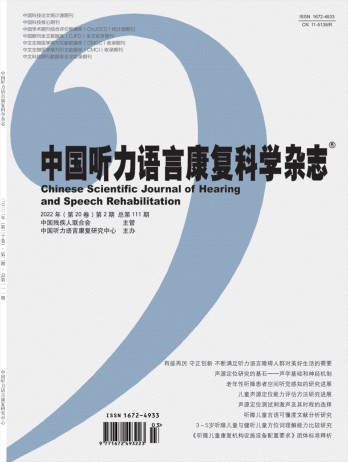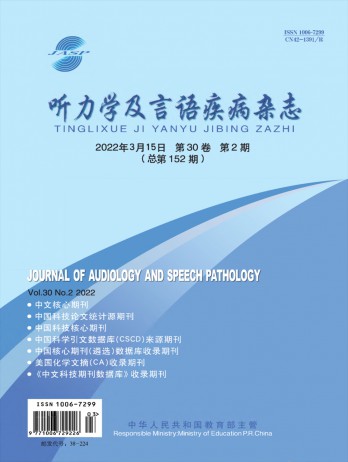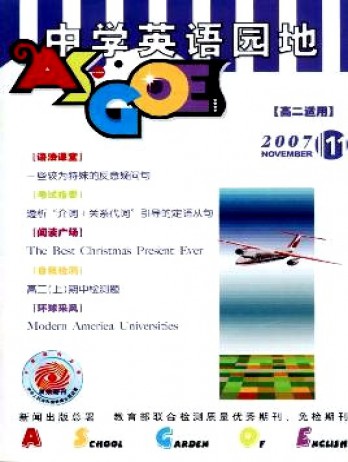听力教学论文精品(七篇)
时间:2022-08-10 15:32:49
序论:写作是一种深度的自我表达。它要求我们深入探索自己的思想和情感,挖掘那些隐藏在内心深处的真相,好投稿为您带来了七篇听力教学论文范文,愿它们成为您写作过程中的灵感催化剂,助力您的创作。
篇(1)
听力可以说是我们中国学生英语学习的最大障碍.我问过很多顺利通过六级考试的本科生,听力部分能真正听懂的实在是寥寥无几.很多人都是根据听懂的只言片语,再利用推理,排除一些的考试策略选择答案的.(国内有些听力教材还提出了只看答案就能选出正确答案的系统 "理论".)这样做考试是有可能通过的,但实际掌握,运用英语的能力就只有自己知道了.
在很长一段时间内,我所选的听力资料将会是VOA的Special级别的慢速英语.这主要是出于两个目的:一是打好基本功;二是从慢速英语入手是科学的方法,是实现标准英语听力突破的有效途径.
先说第一点.
关于听力基本功的认识问题我建议大家去买一本钟道隆编的<<逆向法巧学英语>>一书仔细看看,里面很多道理也说的很清楚了.我这里只想以我的亲身体验 "斩钉截铁"的告诉大家:开始 "真正"练习听力的时候(我这里所提到的 "真正" 不是指那些考试技巧,而是发自内心的想要掌握,运用,享受英语的源动力),千万不可操之过急,一开始就去听那些原版的标准速度的听力资料,一方面这样的方法极不科学;另一方面也会给自己刚刚培养起来的自信心带来巨大的重创.十有八九(也可以说是所有的人)都会很快放弃的.我自己当初也是这样,感觉简直是在听天书,十几分钟的录音下来能够把Topic听准确已经是很不错了,当中的细节部分根本没有时间反应就一闪而过了.这种过程简直就是一种 "煎熬". 当然也有少数意志力惊人的朋友坚持了下来,但是由于方法的失策,造成自己把大量的时间精力(有时可以说是青春)投入其中,可是回报却难以和付出平衡,收效甚微.说到这儿叫我想起以前我们有一位上外的听力老师讲的真人真事:一位研究生深知自己听力不过关,决心发奋苦读.于是他每天早上都坚持听广播电台里的标准英语,这样一听就是五年的时间.这种苦行僧似的磨炼并没有使他的听力水平真正得以提高.后来我们这位老师在了解了他的情况以后,告诉他之所以到现在他的听力还未真正突破最主要的原因就是他的基础没有打好,总是泛泛而听,而且总是听些已经有中文背景知识的广播,就会造成一种错觉,好象什么都听懂了,又好象什么也没听懂.大意能够抓住(其实是有背景知识的原故),真正精确到每一句话,每一个单词却总是丢三落四的,不能准确的传情达意.这种沙上建塔的 "辛劳"永远也不会建成坚固的大厦,而总是在进行建了倒下,倒下了再建的重复劳动.
再说第二点.
从慢速英语入手是真正科学的听力突破方法.而且在我自己的实践过程中摸索出一些听力带动口语,锻炼口译的好方法.下面我想结合我给大家提供的听力资料具体谈一谈练习的方法:
1.下载完相关的听力资料后,用realplayer G2进行播放,我这里暂时不想给大家提供原文,尤其对那些本来就很清晰的听力资料.(不是很清楚的资料我回加入原文的),这主要是希望大家不要依赖原文,自己一定要一个单词一个单词的完全听懂.有的同学说我有那么几个单词实在听不懂怎么办?大家想一想,慢速英语的单词量是1500到2000,也就是说一个比较好的高中生的单词量已经超过了许多,更何况四六级都已通过的你.听不懂的唯一原因绝对不是生词的问题,(这种问题只有在听标准英语的时候才会产生,以后我会和大家专门讨论的)只能是你对这个单词的发音极其陌生,大脑根本没有反映.如果让你看一看原文,你会不屑一顾的.但在听的时候却不知所云.起初我练习的时候有时为了一个单词可以想上正正一天,嘴里老是念道着这个单词的发音.我知道这个单词我一定认识,直到某一刻恍然大悟:咳!不就是这么简单的一个单词嘛!这时我总是猛拍自己的脑袋骂道 "真是愚蠢".:-) 当然如果有些同学说这段录音我已经听了十遍了,当中的几个单词你就是打死我我也听不出来.如果真的到了这个地步,你可以把你的问题发表在世博英语论坛里,我会告诉你答案的.
2.接下来要做的就是要保证这一段录音你是完完全全的听懂了.什么是完完全全的听懂了呢?就是每听完一句话,你都能准确的复述出来,包括每一个单词.这里在语音上不是很好的朋友要注意了,由于是慢速英语,所以只要你
篇(2)
一、引子
由于英语高考加试听力,高中教师对听力教学越来越重视。然而,他们往往把听力课上成听力测试课,课堂教学分成三个步骤:学生听录音,回答问题,师生核对答案。学生经常是在答题的压力下上听力课。长此以往学生对听力课失去兴趣,甚至产生紧张恐惧心理,未能使听力课成为英语学习的有效途径。本文拟根据克拉申(Stephen D.Krashen)的输人假设(Input Hypothesis)和情感过滤假设(Affective Filter Hypothesis)对高中英语听力教学进行探讨。
二、输入假设和情感过滤假设在听力教学中的运用
20世纪70年代末克拉申提出第二语言监控模式。此模式建立在输人假设、习得与学习假设、监控假设、自然顺序假设及情感过滤假设之上。输人假设是指可理解性语言输人,这是监控模式的核心。根据这个假设,语言输人话语既不能太难,也不能太简单,学习者只要获得可理解性语言输人,只要能够听懂对方的话语,语言即可习得。克拉申把学习者现有的第二语言水平定为"i",把学习者将要达到的更高一级的语言水平称为"卜1","i"和"卜广之间的差距是学习者学习的动力所在。语言输人材料的难度要稍高于学习者现有的水平"i","i+l"学习者为了听懂新输人的语言材料,会求助于以前的知识经验或利用语境、上下文等进行判断。通过努力,学习者理解了语言输人中"难以理解的成分",从而使语言习得取得进步。克拉申的输人假设重视学习者理解输人材料时所获得的较高一级的语言形式在头脑中留下的印象。这种印象的有无和深浅与学习者的情感密切相关,决定着语言习得是否成功。由此克拉申提出了"情感过滤"假设。
克拉申指出,"对语言输人的理解是语言习得的必要条件,但是这还远远不够"(Krashen,1982)。学习者必须吸收语言输人中可理解的语言成队习得才会产企他认为学习者心理上会产生一种语言吸收障碍,阻碍了学习者把可理解的语言成份全部运用在语言交际中,他把这种障碍叫做"情感过滤"。"情感过滤"是"无意识的,由于缺乏自信心或焦虑而造成的"(Krashen,1985),即缺乏自信或焦虑阻碍了学习者形成对语言形式的深刻印象,以至于学习者在交际中不能自如地对语言形式进行排列组合。
克拉申的"输人假设"和"情感过滤假设"虽然是在第二语言习得理论的基础上提出的,但对我国的英语听力教学也有一定的指导意义:
(1)学习者必须获得难易程度适中的语言输人;(2)学习者必须理解语言输人材料中的新语言形式;(3)学习者必须具有自信心而且在轻松有趣的环境中学习,以消除焦虑情感;(4)新语言形式必须给学习者留下深刻印象;(5)学习者要经常运用语言进行交际活动。
在教学中教师首先要解决语言输人问题,即选择合适的听力材料。
根据克拉中的可理解输人假设,听力材料应该难易适中。第一,听力材料中出现的语法和单词大部分应该是学生已经学习过的。第二,语连不能太快,也不能太慢。学生在听音时,教师的原则是要让大部分学生能基本听懂所用的听音材料。只有这样,学生才能获得必要的语言输人。若学生不能听懂,何以习得语言?第三,教师要了解学生的听力水平。听力材料不能全班统一,每个学生要根据自己的水平选择听力材料,教师在这方面应给学生提供帮助。每个学生都应有一套连贯的、从易到难的适合自己的听力材料。班里集体听的语言材料要适合大部分学生,并且也应该前后连贯。教师应该根据每个学生的情况建立听力档案,记录学生的听力水平以及所取得的进步。目前,有些学校为学生准备的听力材料不是太易,就是太难,而且前后听的语言材料缺乏连贯性,教师不了解学生能够听懂哪些内容、哪些内容必须师生共同努力才能听懂、应该多长时间调整听力材料的语速等。要解决这些问题,教师应对高中阶段听力教学所使用的教材进行规划,根据学生的听力水平和听力材料的难易程度,有目的、有计划、有步骤地选择和使用教材。
我国的许多中学生,在通过听来学习英语时,焦虑是他们的最大障碍。由于受到听力考试的压力,教师经常指导学生在有限的时间内在多项选择中选出正确答案。在这样的情况下,学生不可能以轻松愉快的心情去听。他们的心情一直处于一种非常紧张的状态之中,惟恐听不懂、做不对,影响考试成绩。学生的这种紧张焦虑情绪阻碍了他们听力水平的提高。因此,在听力课上教师要尽量营造一种轻松愉快的教学气氛,改变那种“听录音—答题—核对答案”的教学模式,努力降低学生的焦虑程度。教师在选择听力材料时,除了要考虑难易适度、语速适中外,还应考虑材料的趣味性以及它们是否符合学生的年龄特点。这些都或多或少地影响学生的情感,进而影响学生的听力学习。
学校应该建立一个听力材料库,听力材料按。级别分类。每一级别的听力材料应形式多样、内容丰富,除有听音磁带外,还应有光盘、录像带“等。学生们除了听以外,还可以看。有趣、形式多样的听力材料能使学生的心情放松,消除他们的焦虑情感,激发他们听英语的兴趣,使他们在.理解语言材料的同时,形成对语言形式的印象与记忆,促进英语学习。
篇(3)
论文关键词:高职学生,词汇学习,语料库,自主学习
词汇是英语语言学习基础要素之一,也是用英语表达思想的基本材料。学生想要提高英语运用能力,用英语流畅地进行听说读写活动,通过各级各类英语能力测试,词汇量不够一直是困扰许多学生的难题。而这个问题对于英语学习基础较薄弱,学习方法和策略比较欠缺的高职高专学生则问题更加突出。由此可见,词汇学习对于高职院校学生的能否提高自己的英语综合运用能力至关重要。
一,目前高职学生英语单词学习的现状调查
根据笔者在数个任教班级学生中进行的单词学习情况调查结果,笔者发现有一部分学生认为大学英语课程单词量多,难度大,教完就很快忘记,缺乏科学的学习和记忆方法,单词记忆效果差。而将近一半的受调查学生则表示识记单词“困难重重”。他们有决心要识记尽可能多的单词,也会坚持复习所学的单词,但在记忆单词时只是通过抱着教材或是四级词汇手册大声重复朗读单词或是默背,默写的方式进行强记。只有一小部分同学能结合一定的句子或语境,来复习记忆单词。此外中学英语教学论文,还有一定比例的学生反映他们通过强化记忆能“认识”许多新单词,但是在四级听力练习中,口头以及书面表达的时候往往做不到合理的语块搭配或是很难应用于正确的语境。因此,我们说学生的词汇能力,不仅在于词汇习得的宽度或词汇习得的数量,还应该注重词汇习得的深度或词汇习得的质量。
学习词汇应该在正确的语块中,语言环境中进行,这样才能真正理解词汇的意义和用法,从而帮助有效记忆。而我们的确发现,目前高职学生大多采用死记硬背的机械式记忆方法,不注重单词的语境联系,把单词孤立开,单个单个的“搬砖头”式的记忆,这样一来,随着学习要求的提高,学生学得很累,只是应接不暇地被动学习,没有正面激励,时间长了,累积的挫败感就使他们就失去了学单词学英语的信心。
从教师教学角度而言,由于更加注重完成教学进度以及兼顾多方面英语语言知识的讲授,许多教师对研究词汇的教学方法少了,有的教师将单词教学和文章学习进行分离式处理,大量灌输单词知识,然后讲解课文,这样的教学模式日复一日,自然对学生学习记忆单词的习惯造成了一定的误导。此外,在课堂单词学习检测环节上,许多教师注重单词本身的听写,要求学生在课堂上能记住拼写、词性、词义等论文下载。将单词作为孤立的个体进行反复操练,强化,脱离应用单词的具体语境。
久而久之,学生受到教师教学思维的影响,必然不重视单词的语境联系中学英语教学论文,导致课后反反复复地单词个体识记,这个枯燥乏味的过程以及效果不甚理想的学习状态又会使他们失去学好英语的信心。
二,利用语料库进行单词学习是帮助学生走出学习困境的有效方法
随着二语习得理论的发展,教师们越来越深刻地意识到学习者本身在学习过程中的重要性和关键性。交际语言教学法提出了“以学生为中心”的教学原则,倡导学习者参与和决定教学内容,让学习者自己的输入成为学习过程的中心。在课堂教学中,教师应该为学生创设学习环境,引导学生自主完成学习任务,成为学习过程中的主角。因而,基于网络的语料库是目前帮助高职学生走出单词学习困境的一种较为有效的新的学习模式。
语料,即语言素材,是自然发生的语言材料的集合。语料库,就是按照特定的目的与方式建立起来的存贮语言材料的“仓库”,语料库中存放的是在语言的实际使用中真实出现过的语言材料。如今,随着网络技术的的广泛使用,基于网络的语料库使用日益广泛。语料库的规模越来越大,种类也日益多元化,语言教学者和学习者和研究者们可以通过网络轻松进入语料库进行自主学习和研究。如美国当代英语语料库(COCA),专门研究中国大、中学生英语学习的语料库CLEC等等。
我们倡导高职学生通过网络途径,在语料库中自主学习相关单词的语料,这是二语习得理论中,以学生为中心教学原则的体现。此外,我们许多教师也认识到,高职院校教学的目的之一是培养学生的自主学习能力,不仅要授之以“鱼”,更重要的是要授之以“渔”。教师应注重引导学生在课堂内外逐步培养学生的自主学习能力。语料库以其丰富的语料资源和方便的检索功能,为广大学生开展课内外自主学习提供了十分便利的平台。
在词汇学习中,语料库作为集合了丰富、典型又真实的语言素材的学习平台,能够有效帮助学习者方便的观察,分析和研究英语词汇的各种特征,准确迅速地把握英语词汇的构词,搭配、语境等多方面语料及信息,从而从质量上提高学习者对单词的掌握程度,达到较好的学习效果。在英语词汇学习中中学英语教学论文,语料库具备以下几个优点。(1)可集中提供丰富的语料,有效解决教材词汇复现率低的问题,更科学地帮助学生全面习得词汇。(2)单词与语境共现,有助于学生学习单词的学习效率。现代语言学研究成果表明,在语境中学习单词的效果要比单独学单词效果更好。因此,语料库中大量真实典型的语例能帮助学生利用语境获取语义和总结规律,达到事半功倍的学习效果。(3)语料库的语例来源于生活,内容真实,准确度高,时效性强,学生接触的是地道的、自然的语言,这有助于提高学生的语言运用能力。
三,语料库在英语词汇学习和教学中的应用
(一)语料库能有助于拓展学生课内外单词自主学习渠道,帮助学生提高单词学习效率
在网络技术普及的今天,广大高职学生可以在课余时间通过网络语料库进行英语词汇的自主学习,建立全新的自主语言学习模式。借助语料库,学生通过关键词查询技术,找出某个单词或结构在语料库中出现的词性、意义、常用搭配以及例句,自主进行研究,从中归纳、发现语言规律,而不再仅仅依赖课堂教师的授课讲义,笔记等有限的学习资源。这种学习方式能摆脱学习时间、空间、以及各院校间学习资源差别等多方面的制约。
此外,基于语料库的英语单词学习模式还有利于培养学生自关键词典工具书更具趣味性,能够激发学生的学习热情和学习兴趣,为更好的课堂教学做好铺垫。
(二)语料库也是教师进行单词研究,转变陈旧教学模式的有效工具
1.在词汇教学内容科学化方面
英语作为一种世界语言在互联网上的应用无处不在,随着计算机技术的日益发展,更新换代,英语也发生着动态的变化。因此,我们的英语教学,为了不落后于语言的发展,也要时时更新,因此用互联网辅助英语教学成了未来的发展趋势论文下载。而英语词汇教学的内容不仅包括词的形式和意义,还包括其句法特征、搭配、语域限制以及多义词、语体特征和文化色彩等多层面的知识信息。面对如此丰富的内容中学英语教学论文,英语教师经常会遇到许多问题,往往在执行词汇教学活动的过程中,由于自己并不是以英语为母语而受到制约,有时候做出判断都凭借自己的语感和经验,不能为学生提供非常清楚的准确的解释。因此,语料库中大量的语言素材是教师进行深入备课,研究词汇知识的一个有利平台。在传授词汇知识时,利用语料库的语例提供单词使用语境,帮助学生区分一些同义词用法的区分,使用频度的差别,一些词的搭配和用法信息等,避免死记硬背的机械记忆,减轻教与学的负担。
2.在教学模式改革方面
目前,大学英语课程教学中,教师注重单词的个体信息,,以大量词汇搭配,派生词等信息的灌输为主,而较少地关注学生学习词汇的主动性。教学模式陈旧,方式单一,学生兴趣索然,课堂效果甚微。英语教师应该充分认识这种被动的局面,重新认识教学过程,改变教学模式,既要在教学活动中把知识、信息,准确、高效地传达给学生,又要提高学生的教学参与度,促进教学更新,为大学英语课堂教学注入新活力。比如我们可以尝试在单词学习环节作这样的改革。首先在,进入新课学习之前,教师引导学生找出本课的核心词汇,然后组织学生进行课后分组自学,通过网络语料库的素材,对核心词汇进行学习。在课堂上中学英语教学论文,教师不再精讲词汇,而是用小组汇报的形式展开交流学习,互相补充,解答疑问,教师则通过总结评估的活动加深学生对词汇的理解和记忆。这样,词汇教学就从单一的教授模式变成了人人参与的互动教学模式,学生真正成为了学习的主体。课后,学生还可以随时利用网络语料库进行复习,以及相关的知识延伸学习,从而提高单词的学习数量和质量,达到有效学习的目的。
语料库对英语词汇和语言教学和研究的作用毋庸置疑,利用语料库辅助词汇教学既能提高学生的学习积极性和自主学习能力,又能在有限的教学时间,资源中提高学生的学习效率,适应语言教学发展的趋势。更重要的是它深刻地改变了我们的语言教学思想,使停留在理论阶段的语言教学思想变成可以实现的现实,比如以学生为中心的教学理念,使用真实语言材料的思想等等。想要让大学英语教学与时俱进,适应时代的发展需要,我们应该充分学习并利用语料库这一工具,为提高英语教学的质量服务。
参考文献:
何安平,2004,《语料库语言学与外语教学》。北京:外语教学与研究出版社。
何安平,2004,《语料库在外语教育中的应用:理论与实践》。广州:广东高等教育出版社。
卫乃兴,李文中,濮建忠等,2005,《语料库应用研究》。上海:上海外语教育出版社。
陈细竹,罗凌基于语料库的词汇自主学习及成效初探【J】。赣南师范学院院报,2005,(5):128-129
陈建生,语料库语言学与英语教学【J】。解放军外国语学院学报,2004,(1):60-64
陈玉,语料库语言学与英语词汇教学【J】。高教论坛,2006,(2),66-70
沈毓菁,1981年11月出生于江苏省苏州市,河海大学英语语言文学学士,现就职于苏州工业职业技术学院公共教学部公共外语教研室,讲师。
篇(4)
在《英语课程标准》的指导下,结合英语作为语言课程的特殊性,进一步开展自主的探索研究,旨在提高学生的英语素养。以更新观念为前提,以育人为归宿,以提高教师素质为核心,以提高课堂教学效率为重点。灵活的课程体系,多元、开放的课程评价标准,重视基础,适应个性需求,关注学生情感,提高学生自主学习能力,为学生构建发展的平台。转变教研理念,改进教研方法,优化教研模式,积极探索在新课程改革背景下的教研工作新体系,努力将新观念、新思路渗透到英语课堂教学之中,真正做到理论与实践相结合。团结奋斗,努力将外语组打造成一支师德高尚、素质精良、结构合理、充满活力、反思型、科研型的教师队伍。
二、工作思路
1、教学目标:培养英语学习兴趣,加强学法指导,抓常态课堂、高效课堂,稳固提高英语教学质量。
2、教研目标:
(1)配合学校及教务处、教研室组织进行校内外的教学研究活动,认真撰写论文,组织老师上观摩课、示范课,通过听课、评课、研讨等形式,做好课后反思,使本组教师理论与实践水平共同提高。
(2)本学期继续加大力度落实集体备课制度,旨在通过集体备课,让教师们更好地掌握课程重点,了解教学难点,形成较完整的备课教案。同一个备课组同一层次的班级要求统一进度、统一作业、统一练习。各年级具体目标如下:
七年级:以构建课堂小组合作模式为契机进一步培养学生学习英语的兴趣,强化基础知识的学习和基本技能的培养,抓好起始年级的英语学习习惯,平时注重口语的训练,切实做到轻负优质。
八年级:加强阅读教学,适当补充阅读材料,注意让学生在阅读中慢慢体会到乐趣,在稳固现有成绩的基础上,强化培优补差,力求进一步提升质量。
九年级:在总结反思的基础上,挖掘潜力,查缺补漏,着力加强学法指导和能力培养,着重对复习课型和中考命题方向和命题的基本原则、方法、思路的探讨研究,为实现11年中考的新突破打好基础。
三、教研活动
1、加强理论学习,更新教学理念,全面推进素质教育。全体英语教师都要抽出时间学习新理论,以先进的教育理念指导自己的教育教学实践。改进评价理念和评价模式,即努力做到关注学生学业成就的同时,还要关注学生情感态度、行为方式的发展,注重培养学生综合实践的能力,全面提高学生的素质。
2、强化教学常规的落实,提高课堂教学效率,组织教师认真学习学校教学常规,指导检查教师的教学工作,特别抓好“备课”、“上课”、“课后辅导”、“培优辅导”等主要环节,鼓励教师充分发挥教学特长,有效提高教学效率。
3、打造“常态课堂、高效课堂”。教研组各教师认真学习常态课堂的基本要求,并每人按计划上一次组内公开课,要求集体备课,及时评课,找出不足,共同学习,共同促进,以学生的主体作用为重点,以合作学习的时效性为重点,从而来实现高效课堂。
4、加强集体备课仍是本学期教研组工作的重点,因此要做到有计划、有目标、有实效。各备课组要集体备课,研究教学内容,研究学生情况,研究教学方法,教学进度、安排及教学资料要一致。每周至少活动一次,时间固定,要有活动记录。每次活动要定中心发言人,定活动主题,做到活动有充实内容,每次集体备课都由指定老师作话题发言,指出每个单元的重点、难点及如何突出、突破的方法,再由备课组全体老师集体讨论、改进,力求精益求精,最终形成一个较好的、统一的方案。备课组要做到“五个统一”,统一进度、统一内容、统一检测、统一作业及通过各种方式对学生做出统一的评价,及时了解反馈,及时调整改进,以提高集体备课的质量。通过集体备课、课堂教学、课外辅导、培优补差等多种形式缩小平行班间的差距,争取整体取得较好的成绩。
5、规范教学的每个环节。教研组要在落实常规方面发挥重要作用,要配合教务处和教研室做好常规落实的检查、督促工作;要定期组织教学研究活动,围绕相应的研究专题,组织相应的公开课、观摩课、示范课,通过研讨、观摩、评议等形式,使教研组全体英语教师能够共同提高,人人受益。
6、组织好英语课外小组活动和竞赛活动。协助教务处做好期中、期末命题双向分析和补缺、补差同学的成绩跟踪,加强考试命题分析的研讨和落实。从中及时了解学生学习的情况,对教学和命题进行调整。建立备课组内教学评价和质量保障体系,以达到自我诊断、自我调解、自主发展的目的。在英语教师中提倡精选习题、精编习题、因材施教。进一步做好英语补缺补差工作。加强九年级毕业班教学工作的研究,提高毕业班教学效率。组织九年级英语教师及全组成员认真学习《英语课程标准》、《2011年连云港市中考说明》,加强对中考动向的信息收集和试题研究,凝神聚力,争取九年级中考听力口语自动化考试成功。扎扎实实做好
一、
二、三轮复习,要在基础知识到位的同时,抓好听、说、读、写综合能力的培养,特别要重视学生阅读能力和写作能力的训练。
7、组织本教研组教师撰写论文。英语组要确定教研专题,全体英语教师通过理论学习和校本培训,不断反思、探索,并联系实际积极撰写英语教育教学论文。积极组织教师参加教育局举办的各类教育教学论文比赛。
篇(5)
论文摘 要:我校经过两年多的时间对课题《如何开发和建设适合农村中学教学的课程资源库》的系统研究,通过多个实验班级教学实践,总结出了在多媒体与网络环境下的课程资源库辅助教学相对于传统模式的教学而言,能更大程度地提高中学生英语听、说、读、写能力,从而更快、更大程度地提高中学生的英语综合语言素质。
一、什么是校园课程教学资源库
教学资源库,其核心内容及功能包括并达到如下要求:保证教师能够通过网络进行备课、资料查询、参与教师培训等工作,保证教师能够通过网络组织、指导学生进行自主学习、协作式、研究性学习等学习活动。资源具有良好的开放性和规范性;资源内容具有权威性、实用性;资源更新及时、形式丰富、容量大。资源库中设置学科素材、教参中心、课件资源、试题库、教学拓展、教学论文、信息技术等栏目。
二、理论依据
1.建构主义教学理论
建构主义学习理论认为:学习者的知识是学习者在一定的情景即文化背景下,借助其他人(包括教师和学习伙伴)的帮助,利用必要的学习材料和信息资源,通过意义建构的方式获得的。主张以学生为中心,强调学生是信息加工的主体,是知识意义的主动建构者。建构主义理念既强调学习者的认知主体作用,又不忽视教师对学生的主导作用。“以学生为中心”的建构主义理念为校园课程资源库辅助教学奠定了理论基础;在网络辅助教学过程中,学生学到的不仅是一门课程所提供的知识点,而且还拓宽了原有的知识面。
2.新课程标准下的课堂教学改革理论
《高中英语课程标准》提倡在老师的指导下,通过观察、体验、实践、探究和合作等积极主动的学习方法,形成有效的学习策略,目的就是提高学生的自主学习能力。而充分开发课程资源库是在高中英语教学中实施《高中英语课程标准》的有效方法。这一理论要求教师成为课堂教学活动的组织者、指导者、合作者。教师要为学生服务,关注学生学习过程,以人为本,以导为核心,牢牢掌握启发、点拨、调控的主动权。这一理论要求凸显学生的主体地位,在教学中学生是否体现学生学习的主动性、参与的全体性、过程的合作性、资源方法理念策略的开放性、知识习得的实践性、学习成果的独创性和学习能力的差异性。学生自主学习、主动探究,这和建构主义学习理论不谋而合,是建构网络教学模式的重要理论依据。
课程资源库辅助教学英语教学仍然以传统的面对面课堂教学为主,辅之以网络资源,以达到改善教学质量、提高教学效率的目的。它在如下两个方面对教学活动起辅助作用:(1)提供一个支持师生利用网络进行教学活动的有效环境,包括备课、授课、复习、答疑、讨论、完成和提交作业、批改作业等。(2)为课程提供一个丰富的教学资源库,支持师生通过网络共享有关的课程资料,包括课程大纲、教材、讲稿、课件、模拟考题、参考资料等。
三、课程资源库辅助教学的优势
随着信息技术的发展,其中利用现代的计算机以及在其支持下的课程资源库辅助教学就是一个很好的选择。计算机,尤其是现代的多媒体网络教学系统,不仅以其声画并茂、形象直观吸引着学习者,而且它所能达到的师生交流、及时反馈功能也吸引了广大的教师。具体来说,课程资源库辅助教学系统突出多媒体和网络两项功能:多媒体教学通过视听结合、声像并茂、动静皆宜的表现形式,生动、形象地展示教学内容,扩大学生的视野,开发学生的智力,培养学生的能力,提高学生的素质,并使外语教学突破了教学信息传播的“时”“空”界限,使人们原本不能在此时此地听到看到的知识信息不仅听到了,看到了,而且信息传递的范围广了,速度更快了,地域更远了,人的各种感官都得到延伸,教学视野不断扩展,教学时间相对缩短。又由于是网络,它可以完成其他教学辅助设备所无法完成的强化教学管理、保证师生交流的任务。
四、课程资源库辅助教学在英语教学中的应用
1.媒体与网络在听力教学活动中
听力教学在英语教学中占着很大的比重,而传统的听力教学局限于老师说,学生听;磁带读,学生听。学生所动用的感官只有耳朵和手。枯燥的教学形式无法吸引学生的兴趣。而在多媒体与网络环境下进行这项教学就要生动得多。例如:我把一学期的课文及单词的录音整理为mp3放在校园网与班级电脑上,学生可以自行下载,每天早读,值日学生可以打开电脑,播放给同学听与跟读。利用《空中英语教室》进行听力训练。因为它配有相应的图像材料有助于学生对听力内容的理解,对人物对话语言所适宜的环境有更深的了解,从而达到准确运用的目的。定期为学生播放原版电影或有声读物,如:titanic,gone with the wind,fair lady,brave heart等,培养学生语感,极大地提高了学生听力水平。网络同时为学生提供更为丰富的远程听力训练及更为有趣的活动形式。另外,我还向学生推荐了两个非常有用的英语学习网站: listeningexpress.com,从中学生可以收听voa special english, bbc world news等英语节目; 4english.cn,从中学生可以收听收看非常有趣的英语节目,如:经典电影片段、电影配音、新闻听力等等。
2.媒体与网络在阅读教学活动中
利用网络收集与课堂教学内容有关的文字、声响及图像材料。仅仅是教材中的那么一点阅读材料是远远不能达到高考所要求的阅读水平的需要的。结合教材主题、增加富有时代气息的真实性材料进行教学来丰富和拓展英语教学内容,可以进一步提高学生的语言综合能力。如在学习澳大利亚一单元时,我们可以随着摄像机的镜头,跟随英语导游,游历广袤的澳洲,观赏澳洲特有的动物;在学习处理废物一单元时,我们在教室里便可看到英语解说的回收利用废纸和易拉罐生产过程的影片和利用风能的科幻影片。学习cloning一文时,可以利用flash,把晦涩难懂的克隆技术变的形象生动,易于学生理解,尤其是文科的同学。
3.媒体与网络在写作教学活动中
现实生活中学生使用英语的环境有限,网络中的师生交流与互动为学生提供充分使用英语的环境。在学习选修8第2单元cloning时,本单元的作文任务为表达正反观点的作文,我进行拓展协作训练,将“手机的利与弊?”这一话题在我班的qq群里,让学生发表看法,互动性很强。经过一定时间的探讨之后,学生将自己的看法以习作的形式利用e-mail发给老师,老师阅读后将学生习作中的一些好的,漂亮的句子与不够到位或表达错误的句子分别摘录出来,再在屏幕上点评,从而在互动中提高了学生的英语写作水平。这比单靠一根粉笔,一张嘴,一块黑板的传统教学省时,但高效多了。
五、课程资源库辅助教学的结果
1.课程资源库的网络资源丰富了英语教学内容
网络教学资源为学生提供了大量的输入材料,校园网对网络报刊、杂志和论坛进行分类和整理,通过链接和引用等多种形式将学生带入适合自己需要的泛读天地。
2.实现了教学方式和学习方式的转变
利用资源库网络教学资源,教师不再是主要的知识源,学生也不再是被动地接受知识,而是知识的探索者。在教学形式上改变传统的教师“独霸讲台,垄断黑板”模式,寓教于乐,多形式,多角度、多渠道去展示、去开发,打破课堂教学封闭性、单调性。
3.提高了学生的英语自主学习能力
正如应用语言学家s.p.corde所指出的,“我们实际上不能给学生教会一门语言,我们只能为他们创设一个适合于外语学习的环境。”课程资源库辅助教学是建立在学生主动参与、主动控制基础上的一种教学模式。课余时间学生可以点击校园课程资源库的网络,根据自己的知识和能力查询所需的课件资源、试题库等获取信息,自主学习。
当然,要真正使课程资源库辅助教学广泛地运用于英语教学的课堂之中,仍然存在着不少问题,也有不少地方需要改进。如:怎样提高教学密度,合理安排课四十分钟时间;如何使多感官的学习更好地符合认识规律,加速学习进度,从而提高学习效率等;如何使资源库为人所有,而不是使用者被资源库的内容所牵制,未经筛选拿来就用等等,这些都是新的课题,需要广大英语教师不断地在实践中探索解决。
参考文献:
1.何克抗.建构主义的教学模式、教学方法与教学设计[j].北京师范大学学报.1997(5)
2.张明敏.网络多媒体技术与应用[m]. 北京:清华大学出版社,1998
篇(6)
一、在语音方面主要体现为辨音能力弱
1.问题:(1)笔者发现,很多单词都是简单的基本词汇,但学生在听录音的时候就是写不出来。(2)不能将发音相近的单词区分开,对英语中音的连读、弱读、同化、不完全爆破等情况不是十分了解和熟悉,导致学生在较快的语流中接触到这类读音时,辨音能力显得尤为薄弱。(3)单词常常造成音、形、义分离的现象。许多词只记得其形和义,对其音却比较生疏,听来比较熟悉的词在听写时却感到生疏,辨听不出来或者拼写没有把握。
2.原因:(1)辨音失败的重要原因是学生的语音基本功不扎实和缺乏这方面的训练。常见的有同音异义或近似音的辨听错误,以及因弱读、连读、爆破、英美音的差异等引起的辨听错误。例如:wear和while,too和to,will和well等基本错误。(2)学生自己的发音不准确,导致听到的音不能和脑中的单词相匹配。(3)对英语的习得通常从阅读发展到听说。在有限的语言学习环境中,对于以中文为母语的学生来说,听说渠道相对阅读渠道要少得多,而以英语为母语的学习通常是从听说发展到读写,与此相反,很容易造成音形义分离。
3.措施:(1)针对学生听辨音能力欠缺的情况,笔者认为除了要加强平时的听力练习,教师应在平时要求学生养成跟磁带朗读的好习惯,并注意纠正学生错误的语音语调,这样,当学生听到发音准确的单词时,才能较快地做出反应。尤其在初一英语学习阶段应侧重加强对英语语音的辨析,同音异义或近似音的辨听,以及听读音写单词等语音基本功的训练。(2)每次听写后,让学生在课后复听,并提供正确答案,意在让学生纠正自己的发音,找出课堂上未辨明或未写对的词,减少拼写、辨音错误。(3)提倡学生在课余或课内大声朗读,而不是默读。这样有利于刺激大脑储存词、句的声音资料,克服词的音、形、义的分离现象,同时能加强语音、语调,提高语感,提高辨音能力。
二、在句子理解方面主要体现为词块组合能力不足
1.问题:通过分析学生的听力听写情况及时与他们沟通,学生常常感到自己明明听清楚了,也没有发现生疏的词语,却非常健忘,或加工不出有意义的、内容连贯的信息。很多学生在听了几遍录音后,整句话只能写出几个不连贯的单词,不能有效抓住句子大意。因此,在听力练习中,我们有必要寻找一种有效的短时记忆方法,从而让听者有更多时间对大量输入语流进行加工,获得有用的信息,提高学生的词块组合能力。
2.原因:(1)学生的词块组合能力很薄弱,很多学生把句子看成单词的简单组合,只想着把每个单词听懂,而不是根据单词之间的意思相关性组成词块记忆,结果导致一方面没有足够的记忆空间记住整个句子中的所有单词,另一方面不能将单词组成有完整意思的句子,在头脑中很难根据上下文对句子进行再现。(2)大脑的短期存储能力是有限的,语言的记忆、储存和输出或使用并不是以词为单位,而是以一些固定和半固定的词语块的模式进行的。也就是说,人们在听到信息时,可以对词按照意群进行组合增加记忆的容量(3)对有关语法知识的掌握不够扎实,没有注意到各部分之间的语义联系。例如:What day is it today?和What’s the date today?这样的错误和混淆,只要弄懂语义就可以规避。
3.措施:教师有意识地锻炼学生的词块组合能力有以下几种方法:(1)在课文或者句子讲解中养成划分句群关系的习惯,把句子按照语义分成不同的句群,加强学生的词块组合能力,或者加强连词成句方面的练习。提高学生的词块组合能力应该是一个渐进的过程,在平时的听写训练中,刚开始可以在听写中进行两三个词的组合,然后随着学生水平的提高,要求他们扩大词块组合的容量,慢慢地从词组延伸到短句,慢慢提高难度。总之,教师要让学生充分认识到,在听力中,不能单独地记忆单词,而应该依据有意义的词块组合进行记忆,把词组、短语、句子看做有特定意义的概念整体。(2)加强学生记存和复述能力的教学。笔者通常运用的教学方法是:选择一段难易程度适合学生听写的文章,以句子或分句为单位,让学生口头复述。需要注意的是断句要足够长,稍超出学生的短期记忆极限,让学生有运用语言经验和其他知识进行再创造的空间。这样既能节省时间,训练方法又简便,能比较好地训练学生的复述、记忆和再创造能力。这种训练不仅要求学生听懂单词,而且要听出它们之间的关系,并将它们作为一个意群、一个整体进行记存并复述出来。
三、在语篇理解方面主要体现为推断能力略显不足
1.问题:在听力练习过程中,学生一听到生词就紧张,并且竭力用心揣摩这个词的含义,以至于影响到整体理解,抓不住全文的中心要点。有时候即使听写几次,有些词仍然听不出。
2.原因:学生推导和猜测能力不足,无法利用上下文的连贯意思和语法结构及语音、语调等推测某一词的含义或者体味说话者的意图。
3.措施:因此应训练和培养学生利用上下文的连贯意思和语法结构及语音、语调等推测某一词的预料能力,笔者通常采取以下步骤:(1)联想。围绕课文题目,引出一系列相关词、词组及课文可能涉及的内容,从语言和主题上为下一步听课准备。(2)猜答案。在听课文之前,让学生先看练习题,并根据学生的经验和知识面判断答案,然后听课文,最后纠正。这种情况下一般选择学生比较熟悉的内容。(3)猜测下文。在听的过程中,可以随时停机,启发学生猜测下面的内容。
四、心理障碍对英语听力的影响
1.问题:学生在听力过程中常常会出现焦虑情绪,对短文的听力理解怀有惧怕心理。这种惧怕心理使得学生在练习或测试中处于过度焦虑的状态,从而影响正常水平的发挥。
2.措施:(1)培养良好的心态,增强对自我情绪的控制能力,充分的自信离不开平时的积累,教师要在平时的教学中重视听力训练,并渗透到日常教学中,通过理论介绍和实践练习让学生掌握科学的听写方法。为听力能力的全面提高打下良好的心理基础。(2)提高学生的英语学习兴趣。在听写训练中不妨选择感兴趣的视听材料,如英语动画片、英文歌曲及适合学生理解的简易英文电影短片和名人演讲材料。让学生充分享受英语,把听英语当成一种很自然的过程。
五、结语
听写是一种比较复杂的言语活动,因此在这一活动中容易犯各种各样的错误,分析学生在听写中常犯的错误有重要的理论和实践价值,它能使我们更深入地了解学生听力理解中的心理过程及影响听力成绩的主要因素,进而为听力训练提供有益指导。
参考文献:
[1]胡文仲.基础英语教学论文集.外语教学与研究出版社.
[2]程晓堂.英语教学与教材分析与研究.外语教学与研究出版社,2002.
篇(7)
论文摘要: 网络使英语教学已经步入一个新的时代,它为英语教学提供了大量信息,让师生有更多双向交流和及时反馈的渠道。本文从国内大学英语教学的现状出发,深入探讨了在网络环境下,如何培养大学生英语自主学习的能力。
发展迅速的因特网正多方面地改变着人们的社会生活,而教育则可以说是受因特网和其它信息传播新技术影响最大的一个领域。近十几年来,多媒体及网络的应用,给英语教学带来了新的方式和有效的途径,现代教育手段日新月异,不断更新。科技既是教学的手段,又是学习的工具,更是信息的源泉。就英语教学而言,已经逐步出现计算机辅助教学、多媒体教学、网络教学等新型教学模式。
网络使英语教学已经步入一个新的时代,它为英语教学提供了大量信息,让师生有更多双向交流和及时反馈的渠道。在网络环境下,传统的一张嘴、一盒粉笔、一块黑板、一张讲台支撑起来的课堂教学模式已很难单独展开下去了,教学改革势在必行。而英语教学模式的改革也必须在符合学生认知规律的基础上,充分发挥现代科技的优势,使教学更加科学化、趣味化、社会化。笔者从国内大学英语教学的现状出发,深入探讨了在网络环境下,如何培养大学生英语自主学习的能力。
一、计算机网络技术对自主学习的支持和促进
网络带来了英语教学的全新概念,打破了国界和其它地域上的界限,真正实现了全球一网。目前很多大学已先后开办了完全通过网络讲授的本科和研究生课程。网络缩短了事物在时间和空间上的距离,任何一个角落的人们都可以及时地了解到事物的最新发展,这对英语教学有着难以估量的影响。其次,网络为学生提供了物质条件和多样的选择机会。例如,大量的文本和视听材料作为语言刺激提供给学生,可供其选择。网络提供了多样化和娱乐化的语言活动,增强了学生学习的乐趣。网络上以多媒体形式储存的资源应有尽有,不论是时事性极强的报刊资源,还是天文、地理、人文、教育、娱乐等资源,更有专门的教学资源,都为学生提供了原汁原味的未经任何处理的资料。学生根据自己的需要和可能,可以弥补课堂上输入有限的不足,自觉自主地利用网上资源,或者利用网络技术和教师进行交流。英语是全球通用语言,学好这一交流工具,学生可以更好地利用网络这一资源。所以,用好网络和学好英语两者是相互促进的。另外,与传统的语言课堂相比,网络技术能更好地给语言学习者创造自主学习的环境。在课堂上,学习者的自主可以和课堂活动紧密结合;而当学习者独立学习时,他们并不一定都知道如何独立地进行有效学习,所以他们需要来自其他方面的指导。例如,如何进行自我评价,确定下一步的计划,规划学习过程和建立继续学习的动机。而网络技术则可以帮助学习者建立学习团体和小组,为群体活动提供服务,把自主学习和课堂、家庭结合起来。
二、如何利用网络技术促进学生的自主学习
首先,要加强对学生自主学习方法的指导。显而易见,学生能够在网络上得到大量的语言学习材料,这是网络环境的一个主要优势。但学生要学会评价他们使用信息的来源的信度和适用性。在这一点上,仍然需要教师的协调和控制,需要教师有一个详细、全面的策略,在课堂上用必要的方法来指导学生,哪些是他们可以选择的,从而找到和利用正确的信息。值得注意的是,教师并不是具体告诉学生应该找什么,而是告诉他们所需要使用的信息的特性,以及如何批判地辨别与最终目标有关或无关的内容。教师还可以安排和划分一系列的学习材料,并且使在线的学生能够找到这些材料。
其次,要正确处理好传统教学与多媒体教学的关系。由于网络提供的学习多是开放型,因此,学生是否到实验室上机学习,他们在多媒体教室干什么,花在英语学习上的时间多少,是我们无从知道的。尤其是在开始的时候,面对浩瀚如海的学习资料和计算机无所不能的各种功能,学生可能会感到无所适从,有的学生甚至可能把时间花在游戏、看电影等事情上,而没有自觉进行有意义的学习。因此,教师要注意对学生的学习进行指导:在每次上新课前要告诉学生每个单元的总课时,如何安排,要达到什么目的;告诉学生上机学习时要学什么内容,完成哪些作业,哪些是学习重点等,同时注意检查他们的学习效果。教师还要时刻关注学生的学习进展情况,注意师生之间的交流和沟通。例如,针对《新视野大学英语》视听说教材,我们每个单元安排四个课时的课堂教学。但这四个课时完全不能处理完一个单元的内容,这就需要学生课后去机房完成所有的听力材料,并且背诵对话。课堂上的侧重点是检查学生课后完成作业的情况,以及进行口语练习。所以,教师要根据学生的实际情况、学生的水平和表现来调整每一部分教学内容的比重,不能放任学生不管,不能让多媒体教学完全代替传统的课堂教学,而是应该让两者有机地结合,平衡传统教学和网络教学的比例关系,有步骤地推行新型教学方法,才能真正发挥多媒体和网络的作用。学生课后完成听力,课堂上就可以围绕课文组织各种讲座和课堂小组讨论或者辩论。对于比较难的话题,教师还可以事先布置范围,让学生利用网络和图书馆资料,充分准备,让他们更有信心,更规范地使用交际语言,以此来提高学生的表达能力,更能使他们的仪态仪表和听力都得到很好的训练。
最后,教师本身也应该树立现代教育理念,很好地适应和充分利用网络这一资源。教师们的现代教育理念意识薄弱,教学模式陈旧,对提高教学质量、培养学生的自主学习能力都是致命的威胁。因为英语教学与其它学科不同,它不是以传授专业知识为主要目的,而是要培养学生应用知识的能力。应用能力的培养只有经过学生在课堂内外大量的英语实践活动来实现,因此,英语教师教学能力的一个重要体现是能否调动学生积极参与英语实践活动,并有效地培养其自主学习能力,即使学生改变学习观念:从“要我学习”到“我要学习”。从这个意义上,英语教师自身有扎实的语言基本功是远远不够的,还需要对现代教育理念的理解,对计算机网络技术的熟练掌握,对课堂教学管理的基本把握,以及调动学生学习兴趣和培养其自主学习的能力。
近年来,随着高校招生规模的不断扩大,学生人数急速增加,而高校大学英语教师人数则相对不足,教师与学生接触的平均时间相对减少,这使高校培养学生自主学习能力的任务更加紧迫。而网络技术的发展为培养学生自主学习能力提供了强有力的条件和支持。教师应该充分利用网络资源,丰富课堂教学,调动学生的学习积极性。还要利用已有的渠道和途径,例如邮件及网络聊天工具等和学生有效地沟通,引导他们充分利用课后时间,自主有效地学好英语、用好英语,掌握好英语这个交流工具,从而更好地与世界交流。
参考文献
[1]顾曰国.网络教育初探[M].北京:外语教学与研究出版社,2004.
[2]田智辉.大学英语教学论文集[C].北京:北京广播学院出版社,2001.
[3]徐锦芬.大学外语自主学习理论与实践[M].北京:中国社会科学出版社,2007.



